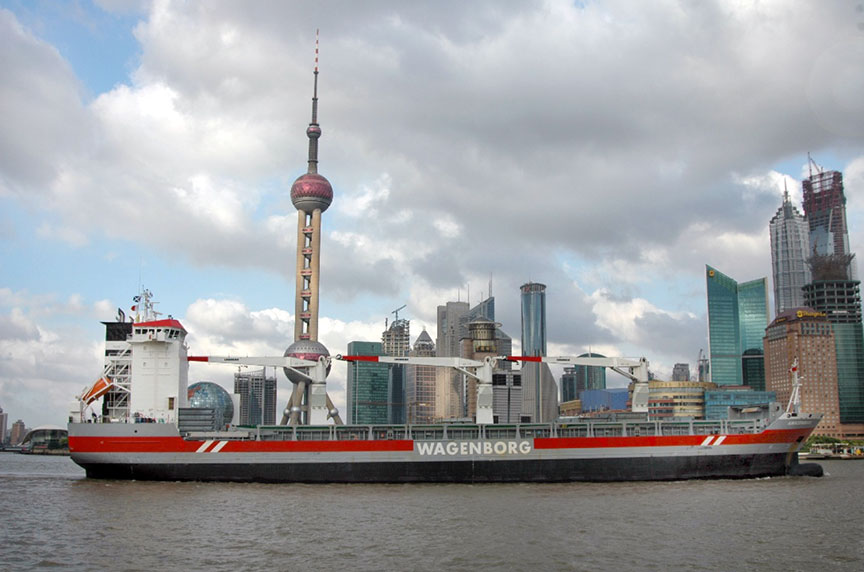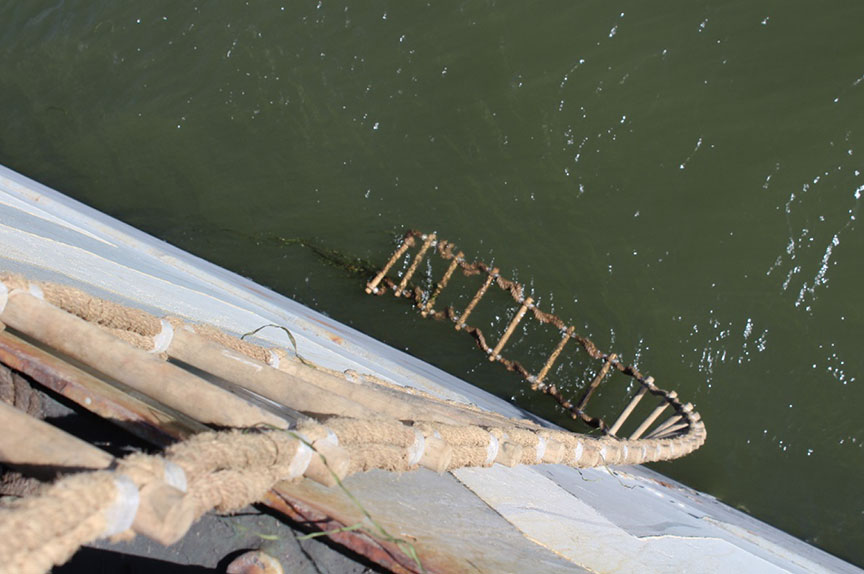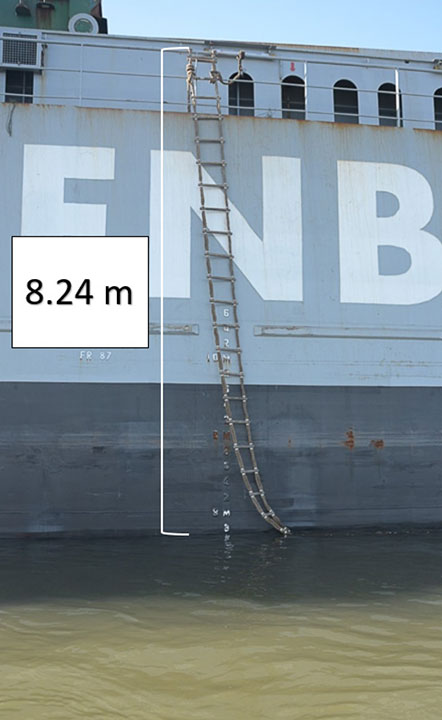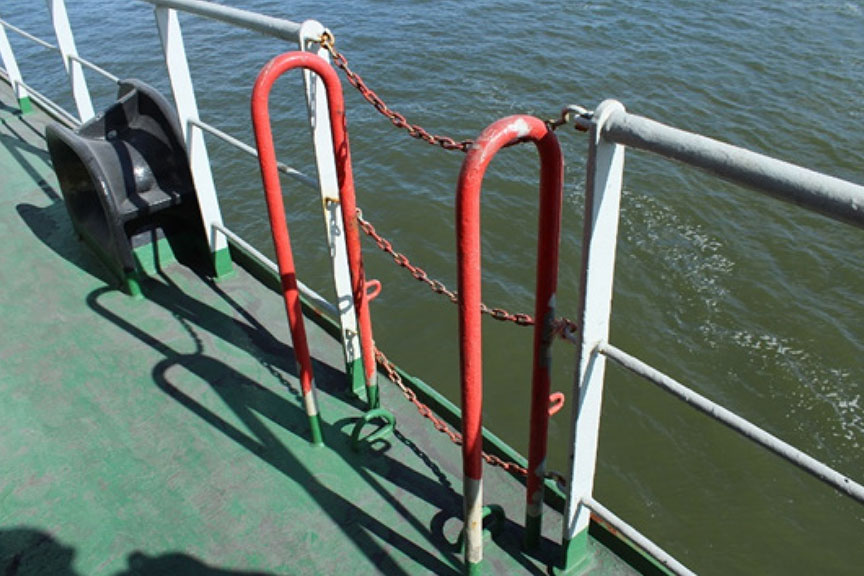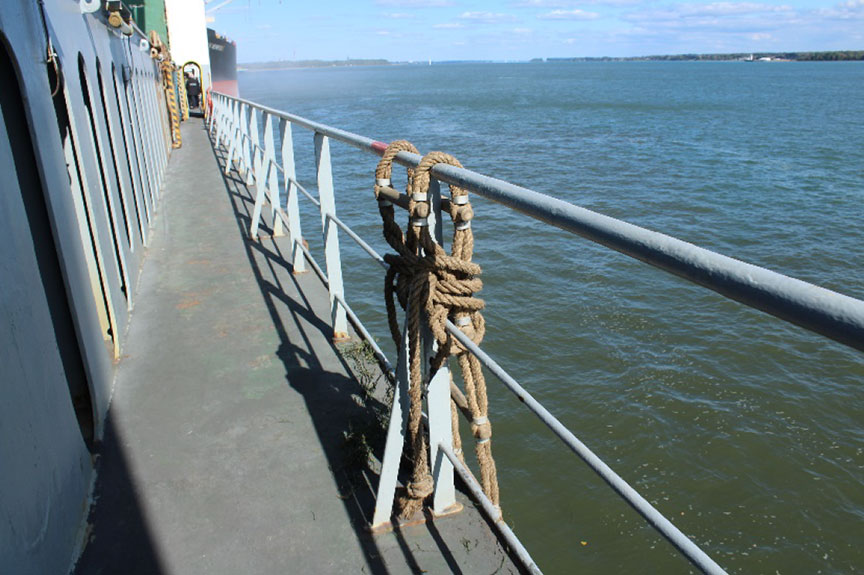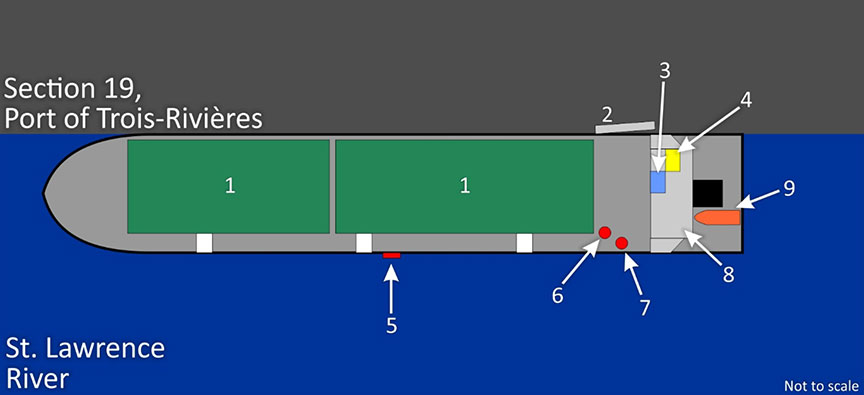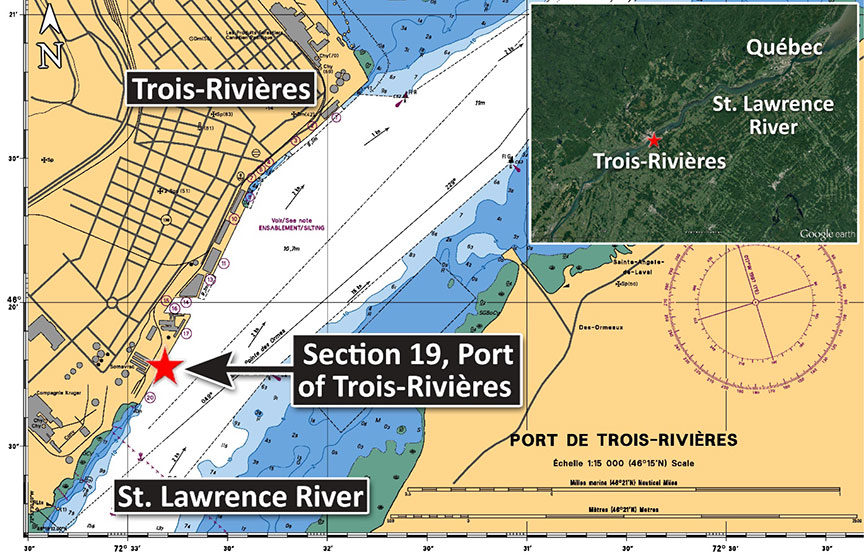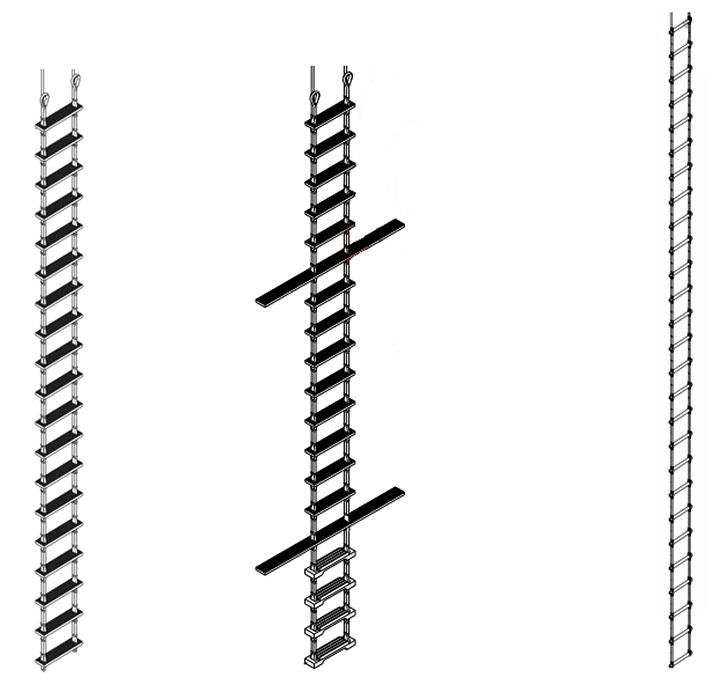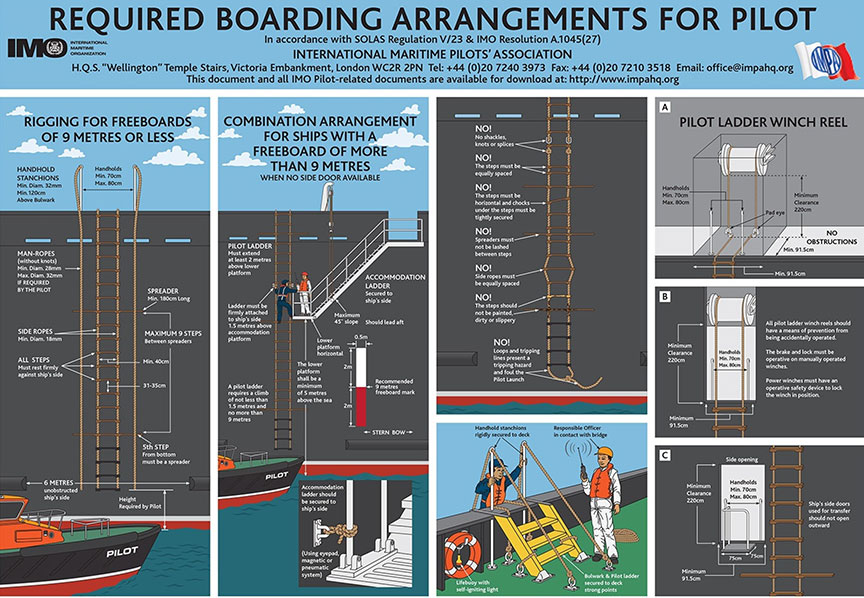Person overboard and subsequent loss of life
General cargo vessel Amazoneborg
Trois-Rivières, Quebec
The Transportation Safety Board of Canada (TSB) investigated this occurrence for the purpose of advancing transportation safety. It is not the function of the Board to assign fault or determine civil or criminal liability. This report is not created for use in the context of legal, disciplinary or other proceedings. See Ownership and use of content. Masculine pronouns and position titles may be used to signify all genders to comply with the Canadian Transportation Accident Investigation and Safety Board Act (S.C. 1989, c. 3).
Summary
On 29 September 2017, the general cargo vessel Amazoneborg was docked at Section 19 in the Port of Trois-Rivières, Quebec. The third officer was assigned to take the vessel’s draft measurements. Some time after 2210 Eastern Daylight Time, the third officer went to read the amidships draft marks on the vessel’s seaward side; he was later reported missing. Search and rescue authorities were notified of the situation and conducted a search of the area without success. The third officer’s body was recovered on 07 October 2017 near Champlain, Quebec.
1.0 Factual information
1.1 Particulars of the vessel
| Name of vessel | Amazoneborg |
|---|---|
| International Maritime Organization (IMO) number | 9333541 |
| Port of registry | Delfzijl |
| Flag | Netherlands |
| Type | General cargo |
| Gross tonnage | 11 864 tons |
| Length, overall | 143.00 m |
| Draft | 9.69 m |
| Depth (moulded) | 13.3 m |
| Built | 2007, Hudong-Zhonghua Shipbuilding Co., Ltd., Shanghai, China |
| Propulsion | 1 medium-speed 4-stroke diesel engine (7800 kW), driving a single 4‑blade controllable pitch propeller |
| Cargo | Nickel concentrate in bulk |
| Crew | 14 |
| Registered owner | Wagenborg Shipowners B.V., Netherlands |
| Manager | Wagenborg Shipping B.V., Netherlands |
1.2 Description of the vessel
The Amazoneborg (Figure 1) is a general cargo vessel with 2 cargo holds and 2 hydraulic steel hatch covers. Three 60-tonne electro-hydraulic cranes are located on the vessel's port side. The engine room and accommodation spaces are located aft. Floodlights located below the wheelhouse windows on the forward side of the accommodation space illuminate the main deck.
The vessel office and the crew locker room are located on the starboard side of the main deck, within the accommodation space (Appendix A). Port and starboard side accommodation ladders are located between the cargo hold and the accommodation space. The vessel is equipped with 1 rescue boat, located on the aft port side of the poop deck.
1.3 History of the occurrence
On 28 September 2017, at 2115,Footnote 1 the Amazoneborg arrived at Section 19 in the Port of Trois-Rivières (Appendix B) and docked on its starboard side in order to load bulk nickel concentrate the next day.
On 29 September, at 0600, Transport Canada (TC) inspectors boarded the vessel to perform their duties as inspectors of cargo,Footnote 2 while the second officer was on deck watch duty. At 0615, an independent draft surveyor came on board for the initial draft survey.
Around 0630, under the supervision of the draft surveyor, the bosun, one of the able seafarers, and the second officer descended a Jacob's ladderFootnote 3 previously rigged to the guardrail on the vessel's port side in order the read the amidships draft marks. After reading the draft marks, the second officer returned to the main deck; the ladder was raised, rolled up, and left on the main deck.
At 0800, the third officer was on deck watch duty as bulk cargo loading operations began at 0805. At 1200, the third officer was relieved by the second officer.
At 1730, the second officer handed over the deck watch to the third officer, and, at 1800, the third officer assumed responsibility for the watch. Meanwhile, the chief officer remained in the vessel office to supervise the loading operations and the third officer. During his watch, the third officer retrieved the draft measuring tape from the vessel office.
At 2200, while monitoring the progress of the ballast stripping and cargo loading from the vessel office, the chief officer ordered the third officer to read the vessel's draft marks.
At 2202, the third officer disembarked onto the dock and read the 3 draft marks on the vessel's starboard side.
At 2215, the third officer reported the draft readings to the chief officer via ultra high frequency (UHF) radiotelephone. The chief officer then requested that the third officer order the terminal operator to begin loading the cargo on the vessel's starboard side in order to compensate for a list to port; the chief officer also ordered the third officer to read the port-side draft mark. The third officer acknowledged and responded that he would read the amidships draft marks on the port side. The third officer reboarded the vessel and proceeded to the port side of the main deck, passing the able seafarer, who had been posted at the accommodation ladder for the security watch. The able seafarer was the last person to see the third officer (Appendix A).
Around 2225, the chief officer made several attempts to contact the third officer by UHF radiotelephone, without success. The chief officer and the able seafarer then searched the main deck for the third officer.
During their search, they found the Jacob's ladder used in the initial draft survey lowered and hanging over the port side at amidships. The last few rungs of the ladder were in the water and moving with the current (Figure 2 and Figure 3). A crew member found the draft measuring tape on the port side of the main deck (Appendix A).
The chief officer proceeded to the accommodation space to inform the master of the situation. On his way, the chief officer walked through the crew locker room and saw the third officer's personal flotation device (PFD) in his locker.
At 2240, the chief officer informed the master that the third officer was missing. The master searched the deck area for the third officer without success and then ordered the crew to prepare the vessel's rescue boat.
At 2251, the master proceeded to the wheelhouse to initiate the man overboard procedure. A few minutes later, he activated the vessel's man overboard alarm with 3 long blasts of the vessel's whistle and used the public address system to order the crew to muster on deck. The master then used a very high frequency (VHF) radiotelephone to contact Marine Communications and Traffic Services, which issued a mayday relay at 2300.
At 2301, the vessel's rescue boat was launched. Shortly thereafter, with the help of local authorities, crew members began to search for the third officer on board, on the water, and ashore. The crew on the vessel's rescue boat used its UHF radiotelephone to maintain contact with the crew remaining on the Amazoneborg.
Between 2307 and 2345, Marine Rescue Sub-Centre Québec tasked the pilot boat Jean H., the tanker Chem Ranger, and the tug Ocean Bravo to search the area; the local fire department launched its rescue craft and joined the search. Communication among these resources was conducted via VHF radiotelephone. The municipal police informed port security of the situation and the master informed the company.
On 30 September, at 0400, the Amazoneborg's rescue boat returned to the vessel. Later in the morning, 2 Canadian Coast Guard vessels—the air cushion vehicle Sipu Muin and an auxiliary vessel—were tasked with searching for the third officer.
At 1648, all search and rescue units were ordered to stand down.
On 07 October, the body of the third officer was recovered by the provincial police force, the Sûreté du Québec, near Champlain, Quebec.
1.4 Autopsy results
An autopsy and a full toxicological examination were carried out on the body of the third officer; nothing was found that could have led or contributed to the accident. The coroner's report determined that the cause of death was likely drowning and identified minor injuries that may have been due to a fall into the water.
1.5 Environmental conditions
On 29 September, at 2200, the wind in Trois-Rivières was from the north at 6 knots. The air temperature was 7 °C, and the water temperature was 19.6 °C. The sky was overcast, and visibility was 9 nautical miles (nm). Near Section 19 of the Port of Trois-Rivières, the current was 1.5 knots,Footnote 4 and the wave height was 0.3 m to 0.6 m.
1.6 Vessel certifications and inspections
The Amazoneborg carried all required certificates for a vessel of its class and intended voyage:
- The flag state's recognized organization had previously inspected the vessel and renewed its Certificate of Class on 01 March 2017.
- The vessel's Cargo Ship Safety Certificate and the supplemental Record of Equipment for Cargo Ship Safety (Form C) was issued on 31 August 2017.
- The vessel's Safety Management Certificate was issued on 24 March 2017.
- The vessel's Maritime Labour Certificate had been issued on 10 May 2013, and a Declaration of Maritime Labour Compliance Part I had been issued on 06 November 2012. The recognized organization had conducted an intermediate inspection on 08 June 2015, which found the vessel to be compliant with Maritime Labour Convention (MLC) 2006.
1.7 Personnel certification and experience
The master held a master certificate of competency. He had started sailing with the company in 2006 and had become a master in 2015. This was his third 3-month contract as master of the Amazoneborg.
The chief officer also held a master certificate of competency. He had sailed with the company since 2004, had held the position of chief officer on various vessels since 2008, and had held the position of chief officer on the Amazoneborg since 2014.
The second officer held a chief mate certificate of competency. He had started sailing with the company in 2012 and had held the position of second officer since 2016. At the time of the occurrence, he had completed 2 contracts as second officer on the Amazoneborg.
The third officer held an officer in charge of a navigational watch certificate of competency. He had joined the company in 2013, completed his apprenticeship on 2 company vessels similar to the Amazoneborg, and had sailed as third officer on board a vessel similar to the occurrence vessel in 2015. He had joined the Amazoneborg as third officer in June 2017. The third officer's familiarization training record was completed on 26 June 2017. The record attests that the crew member “is aware of the on board risk assessment instruction in part 17 of the Shipboard Operation Manual and the availability of safety sheets to ensure personal safety” and “is aware when and which personal protective aids [are] to be used.”Footnote 5
The able seafarer held an able seafarer deck certificate of proficiency. This was his 3rd contract as able seafarer on the Amazoneborg.
1.8 Survivability
The third officer was last seen wearing safety boots, a safety helmet, gloves, coveralls, and a jacket when he was assigned to take the draft measurements. A manual inflatable PFD was found in the third officer's locker at the time of the occurrence.
Exhaustion can increase rapidly when a person attempts to stay afloat, especially if not wearing a PFD and swimming against the current.
1.9 On-board personal protective equipment
All necessary personal protective equipment (PPE) was available to crew members on the Amazoneborg at the time of the occurrence. Each crew member was provided with a manual inflatable PFD, which was stored in his or her locker in the crew locker room along with automatic inflatable PFDs with an integrated safety harness. A PFD provides extra buoyancy to assist a person in remaining afloat. Safety harnesses with a self-retracting fall arrest device (fall protection system) are required by the vessel's shipboard operation manual when working above water; these were available in the crew locker room. They anchor a crew member to a secure part of the vessel and prevent him or her from falling into the water. A fall protection system requires preparation time (to set up and put on the system) and the presence of another crew member while it is in use.
1.10 Types of rope ladders used on board ships
1.10.1 Pilot ladders and embarkation ladders
Pilot and embarkation ladders are common throughout the marine industry; certain vessels are required to carry them for embarking and disembarking. These ladders are designed to rest firmly against a vessel's side and have safety features to reduce the chances of slipping or falling, including flat, non-slip steps and spreadersFootnote 6 (for pilot ladders) (Appendix C).
The International Convention for the Safety of Life at Sea (SOLAS)Footnote 7 recommends measures for the safe boarding of pilots, as well as standards for the construction, proper rigging, and arrangement of pilot ladders and other equipment used for pilot transfers (Appendix D). Embarkation ladders are also subject to SOLAS regulations and International Maritime Organization (IMO) standards to provide a safe means of evacuating crew and passengers into survival craft.
In accordance with SOLAS, the Amazoneborg’s guardrail is equipped with 6 gateways at various locations for pilot and embarkation ladders (Figure 4). Each gateway is fitted with a removable chain or gate and handhold stanchions. The handhold stanchions and the securing strong points are permanently welded to the main deck. They ensure a safe means of transferring between the ladder and the deck. None of these gateways are aligned with or near the vessel’s amidships draft marks.
At the time of the occurrence, 1 spare pilot ladder and 1 spare embarkation ladder were available for general use on board the Amazoneborg.
Because of their particular design and construction, pilot ladders and embarkation ladders are heavier to handle and require more personnel to rig and carry than Jacob's ladders. An average pilot ladder weighs approximately 88 kg and an average embarkation ladder weighs approximately 65 kg, whereas an average Jacob's ladder weighs approximately 17 kg.
1.10.2 Jacob's ladders
1.10.2.1 Description of the Jacob's ladder
A Jacob's ladder (also known as a monkey ladder) is a flexible hanging ladder composed of vertical rope or chain and horizontal wooden or metal rungs. This type of ladder is commonly found and used for various applications throughout the marine industry.
The design and construction of Jacob's ladders are not subject to any international standards. In Canada, the Safe Working Practices Regulations, which apply to any vessel in Canada, state
- Every Jacob's ladder shall be of sufficient length to reach the intended landing point and the means of attachment thereof to the ship shall be effective and maintained in a safe and good condition.
- Every portable ladder shall be maintained in a safe and good condition and shall be secured to prevent its shifting and slipping when in use.Footnote 8
Some other states, such as the United Kingdom, provide guidance on the construction of rope ladders:
- The steps must provide a slip-resistant foothold of not less than 400 mm × 115 mm × 25 mm and must be so secured that they are firmly held against twist, turnover or tilt. [...]
- Ladders of more than 1.5 metres in length must be fitted with spreaders […].Footnote 9
At the time of the occurrence, 2 Jacob's ladders were on board the Amazoneborg. They were made up of round wooden rungs inserted between manila ropes and attached with aluminum clamps. The ladder used in the occurrence was 9.4 m long, with rungs 34 mm in diameter and 400 mm long. When resting on a flat surface, other than the areas immediately surrounding the clamps, the ropes lie flat. The distance from the flat surface to the outer edge of the rung is 42 mm, which provides a toehold of approximately 25 to 35 mm (Figure 5).
The Jacob's ladders on board the Amazoneborg did not have identifying marks or labels; the investigation was unable to determine the manufacturer.
At the time of the occurrence, monthly inspections were performed on the Amazoneborg's Jacob's ladders, and the last inspection had been performed on 02 September 2017. The inspection report indicated that the ladders appeared to be in good condition.
The TSB's examination of the ladder used in this occurrence also indicated that the ladder appeared to be in good condition.
1.10.2.2 Jacob's ladder rigging
The Jacob's ladder used in this occurrence was rigged to the guardrail, above the amidships draft marks (Figure 6). This portion of the guardrail consisted of permanent rails and stanchions. On board the Amazoneborg, Jacob's ladders were typically rigged in this manner. During installation, the length of the ladder was typically adjusted according to the vessel's freeboard so that it hung above the water. To transfer between the deck and the ladder, the user had to climb up the guardrail, straddle it briefly, and then descend the guardrail. The permanent guardrail is intended to prevent personnel from falling overboard and is not intended to secure a ladder.
1.11 Industry practices
1.11.1 Working overboard
Working overboard (also known as working over the side, aloft, or outboard) involves working on the vessel's side and carries a risk of falling into the water. This work is normally done using stages, boatswain's chairs, ladders, small boats, or a suitable platform or basket lifted by a crane.
The MLC 2006 requirements regarding occupational accidents and injuries on board vessels state that provisions under regulation 4.3 “should take into account the [International Labour Organization's] Code of Practice entitled Accident prevention on board ship at sea and in port, 1996.”Footnote 10 According to this code, the following safety precautions should be taken when crew members are working overboard:
- PPE (fall protection system and PFD) should be worn.
- Another crew member should be present to supervise and assist as needed.
- A lifebuoy with a safety line should be readily available.
- A work permit should be obtained.
- A risk assessment should be conducted.Footnote 11
With regard to the rigging of rope ladders, the code states that “rope ladder[s] should be properly secured but never secured to railings, or to any other means of support, unless the railings or support will safely take the weight of a person and the ladder.”Footnote 12
1.11.2 Draft measurement
The draft marks on a vessel's hull indicate the vertical distance in metres or feet from the bottom of the keel to the waterline and are located on a vessel's port and starboard sides at 3 points: forward, amidships, and aft. By taking draft measurements (also known as reading draft marks or performing a draft check), officers or draft surveyors determine the vessel's displacement.Footnote 13
Draft measurements can also establish the weight of the cargo through applying calculations and corrections. An independent draft surveyor conducts an initial draft survey before the bulk cargo is loaded or unloaded, and a final draft survey when these operations are completed. The surveyor then determines the exact weight of the cargo by calculating the difference between the initial and final draft survey and applying the appropriate corrections. A high degree of accuracy is required when taking these draft measurements.
Throughout loading and unloading operations, officers must regularly perform intermediate draft checks on both sides of the vessel.Footnote 14 These checks are carried out to monitor loading or unloading operations, to determine the vessel's trim and list, and to calculate the vessel's shear stressFootnote 15 and bending moments.Footnote 16 These readings can be less accurate than the draft surveys.
To determine the dockside draft, an officer or draft surveyor stands on the dock to read the draft marks at the forward, amidships, and aft points along the vessel. To determine the seaward draft, it is common for the officer or surveyor to descend a rope ladder to read the draft marks. Because the observer is at the same level as the draft mark, this allows for an accurate visual reading and avoids parallax error.Footnote 17 However, it has been noted that
Although it is a common practice to read the offside draught marks from a rope ladder, a launch or small boat provides a more stable environment and brings the observer to a safer position closer to the water line.Footnote 18
In some situations, reading the seaward drafts marks may be impractical or dangerousFootnote 19; in such instances other methods may be employed, including making observations from a small boat or using a manometer, a draft measuring tape, a draft gauge, or a calibrated inclinometer. The method chosen by the observer depends on the level of accuracy required.
1.12 On-board practices for draft measurements
Before the occurrence, officers on the Amazoneborg routinely read the vessel's forward, amidships, and aft draft marks during the loading and unloading of bulk cargo, to monitor bulk cargo operations. They usually took amidships seaward draft measurements from the main deck, by lowering the draft measuring tape or by looking down over the guardrail to read the draft marks. To determine the vessel's dockside draft, officers read the draft marks from the dock.
However, during a draft survey, an officer would accompany a draft surveyor to take the vessel's initial and final draft measurements. The amidships seaward draft marks were routinely read by the crew using one of the vessel's Jacob's ladders, because a more accurate draft reading was required. Ship's officers did not consider this task as working overboard according to the shipboard operation manual. However, some officers were aware of the hazards involved and had developed an informal practice of donning a PFD and being supervised by other crew members with access to radio communications and a lifebuoy. When officers read drafts marks from the dock, it was not standard practice to wear a PFD.
In the early morning before this occurrence, a draft surveyor had boarded the vessel to complete the initial draft survey. This surveyor was prohibited by his employer from using a Jacob's ladder. The second officer, wearing a PFD, then used a Jacob's ladder already rigged to the guardrail to read the amidships seaward draft marks for him. The ladder was then raised, rolled up, and left on the deck.
1.13 Perception of risk regarding routine tasks
Research on changing work practices has shown that, in part because of the contextual factors of the physical and economic environments in which they occur, unsafe work practices can be difficult and slow to change.Footnote 20 Crews may routinely work without experiencing accidents, which reinforces any unsafe work practices.Footnote 21 Taking a vessel's draft measurements involves particular hazards and risks that must be managed. Risks associated with this task can become normalized through repetition. Each time the task is successfully performed, the perception of the severity of the risks decreases.Footnote 22,Footnote 23
1.14 Health and safety management systems
1.14.1 International Safety Management Code
The objectives of the International Safety Management (ISM) Code, which has been adopted by the IMO, are to ensure safety at sea, prevent human injury or loss of life, and avoid damage to the environment. According to the ISM Code, a company's safety management objectives should be to provide for safe practices in vessel operations and a safe working environment by assessing all identified risk to vessels, personnel, and the environment; to establish appropriate safeguards against those risks; and to continuously improve the safety management skills of personnel ashore and on board vessels.Footnote 24 The ISM Code, which applies to all SOLAS convention vessels over 500 gross tonnage and all passenger vessels, requires companies and vessels to develop and implement a safety management system (SMS). Chapter 7 of the ISM Code states that
The company should establish procedures for the preparation of plans and instructions, including checklists as appropriate, for key shipboard operations concerning the safety of the ship and the prevention of pollution. The various tasks involved should be defined and assigned to qualified personnel.Footnote 25
Companies should ensure that the SMS used on board a particular vessel includes procedures and instructions to avoid unsafe practices. Accordingly, companies should keep their procedures simple and straightforward and should include routine operations such as reading draft marks.Footnote 26
1.14.2 Maritime Labour Convention
The MLC 2006 applies to vessels (such as the Amazoneborg) and vessel owners of flag states that have ratified the conventionas well as to all vessels sailing in the territorial waters of a flag state that has ratified the convention (such as Canada and the Netherlands). The MLC 2006 sets out provisions to protect seafarers' rights and work conditions, such as occupational health and safety and accident prevention.
1.14.3 Company health, safety, environment, and quality management system
In May 2017, a document of compliance was issued by the flag state's recognized organization to the company, indicating the company's compliance with the ISM Code. This recognized organization had reviewed the company's Declaration of Maritime Labour Convention Compliance Part II on 22 November 2012 and found the company compliant with the MLC 2006 and with the Dutch flag administration's requirements. In accordance with the ISM Code, MLC 2006, and other standards, Wagenborg Shipping B.V. has a Health, Safety, Environment and Quality Management (HSEQ) System, which includes shipboard operation manuals specific to each series of vessels, and a company manual.
The company manual issued on 01 October 2016 contains procedures and information on the company's management system, including organization structures, responsibilities, corrective and preventive actions to be taken, incident and hazardous situations reporting, internal audits, and occupational health and safety management. It does not provide information on specific tasks such as working overboard and taking draft measurements.
The Amazoneborg's shipboard operation manual was revised on 01 November 2016. The manual contains general operation and safety procedures for the company's A-series vessels, as well as risk management procedures and instructions on risk assessment and PPE. According to the manual, crew members can assess risks and hazards using 5 methods:
- last-minute risk assessment (personal risk assessment)
- safety briefing
- permit to work, for entry into enclosed or confined spaces, hot work, and working at height or overboard, which includes a specific instructional safety sheet
- risk assessment safety sheet for unforeseen jobs
- external risk inventory and evaluation
The shipboard operation manual did not include any procedures or instructions for taking draft measurements.
1.14.3.1 Safety briefing
At the time of the occurrence, according to the Amazoneborg's shipboard operation manual, a safety briefing was required for specific shipboard operations, such as
- mooring and unmooring,
- entering into enclosed or confined spaces,
- operating hatch cover cranes,
- handling the tween deck and the bulkhead,
- checking cargo,
- using the vessel's cranes, and
- unforeseen jobs.
Safety briefings are required to be recorded in the applicable logbook. The investigation found no record of a safety briefing having been held the day before or the day of the occurrence. There is no explicit requirement to conduct a safety briefing prior to working overboard or taking draft measurements.
1.14.3.2 Safety sheet and permit to work overboard
Draft measurements can be taken in several ways, one of which involves reading the vessel's draft marks from a ladder while working overboard. At the time of the occurrence, no guidance on taking draft measurements was provided to the crew in any company instruction or procedure. The Amazoneborg's shipboard operation manual indicates that work performed overboard requires a permit. An instructional safety sheet accompanies this permit to help crew members identify hazards and precautions to take while working on deck, overboard, and at heights.
The permit to work overboard contains a checklist for pre-work preparation items that includes PPE, communications equipment, safety equipment, and the condition and installation of other equipment to be used. Specifically, the permit checklist asks whether the Jacob's ladder is in good condition and has been inspected. The permit to work overboard does not prohibit the use of a Jacob's ladder on a flat surface, such as for reading draft marks. The permit also does not specify the need for a crew member to stand by while another crew member is working overboard.
The permit is a general permit for all kinds of work performed overboard and is valid for a period of time for the crew members performing the work. The permit must be completed by the responsible officer and signed off by the master, the responsible officer, and the crew member to whom the work is assigned.
The investigation found that no permit to work overboard was issued on the day of the occurrence, and no permit to work overboard had been issued on board since 31 October 2016.
1.14.3.3 External risk inventory and evaluation
In 2012, as required by the Dutch Working Conditions Act, the IMO, and the MLC 2006, an occupational health and safety risk inventory and evaluation was performed on the Amazoneborg by an authorized expert. A report was issued upon completion of the evaluation, which included information about risks on board, such as working at heights, and detailed action plans with mitigation measures. The report was made available to crew members for reference. However, the report did not include any information about the risks involved in taking draft measurements.
1.14.3.4 Personal protective equipment
The Amazoneborg's shipboard operation manual includes a page on PPE that establishes the equipment that employees should wear for specific tasks. This page states that, when working above water, the following PPE is mandatory:
- helmet
- gloves
- coveralls with reflection (winter)
- safety footwear
- safety harness with self-retracting fall arrest device
- inflatable PFD
At the time of the occurrence, other tasks that involve a risk of falling into the water, such as working on the dock, were not mentioned in the list of tasks for which PPE was required.
1.14.3.5 Audits
On 24 March 2017, an ISM Code renewal verification was conducted on board the Amazoneborg by the flag state's recognized organization. The external audit report noted insufficient reporting of hazardous occurrences by crew, despite the fact that this issue had previously been identified in an internal safety audit conducted by the company on 30 August 2016, and despite corrective action encouraged by the vessel's master in subsequent safety meetings.
Another internal audit conducted on 25 August 2017 reported 3 observations on the general safety of the vessel.
Neither audit highlighted any non-conformities, observations, or suggestions regarding crew compliance with the company's procedures for working overboard.
1.15 Port State Control inspection
Port State Control is an internationally agreed vessel inspection program under which foreign vessels entering the waters of a sovereign state are boarded and inspected by Port State Control officers to ensure compliance with various major international maritime conventions.Footnote 27 In Canada, Port State Control inspections are carried out by TC in accordance with the Paris and Tokyo Memoranda of Understanding on Port State Control. The Paris Memorandum of Understanding states that “overriding or unexpected factorsFootnote 28 might trigger an inspection in between periodic inspections” and that “the need to undertake an additional inspection is for the professional judgement of the Authority.”Footnote 29
In accordance with the Canada Shipping Act, 2001,Footnote 30 TC inspectors boarded the Amazoneborg and conducted an inspection following the occurrence. Following the inspection, no Port State Control inspection report was written and no deficiency was recorded.
1.16 Related occurrences
On 01 October 2016, an incident similar to this occurrence took place on board a vessel, the Reestborg,owned by the same company. While reading the amidships seaward draft marks using a Jacob's ladder, the third officer of the Reestborg lost his balance and fell into the water. His PFD inflated, and he was able to hold onto the ladder, call for attention, and climb back onto the ladder and then back on board the vessel. The third officer sustained minor injuries as a result of this incident.
Following the incident, the vessel's master held a safety meeting and conducted an investigation by completing a general report, as required by the company's procedure. In the safety meeting, the master of the Reestborg gave the following instructions to his officers:
- Use the draft measuring tape to take amidships seaward draft measurements.
- If a ladder is required, use a pilot ladder and wear appropriate PPE (such as a fall protection system and a PFD). Have another crew member standing by with a lifebuoy and access to good radio communication.
- Wear a PFD when reading the draft marks from the dock.
The master's general report was submitted to the company. In November 2016, as required by the company's procedures, the HSEQ System staff shared this information with the fleet by publishing the master's article “USE OF LIFEJACKET, a lifesaver!”Footnote 31 in the company's publication, FleetNews.Footnote 32 The article also emphasized conducting a proper safety briefing before engaging in tasks such as working overboard.
Since 2013, the TSB has received reports of 4 occurrences involving crew members working overboard; one of them is related to this occurrence:
M17C0292 (Federal Champlain): On 08 December 2017, in Thunder Bay, Ontario, the third officer on board the bulk carrier Federal Champlain fell into the water from a ladder he was using to read the amidships seaward draft marks. The third officer was rescued by one of the terminal's small vessels, sent to the nearest hospital for treatment, and released a few hours later.
1.17 TSB laboratory reports
The TSB completed the following laboratory report in support of this investigation:
- LP266/2017 – Rope ladder analysis
2.0 Analysis
The investigation found that, while the vessel was docked at Section 19 of the Port of Trois-Rivières, the third officer of the Amazoneborg likely fell into the water while using a Jacob's ladder to read the vessel's amidships seaward draft marks. There was no indication that the ladder malfunctioned.
The analysis will focus on the events leading to the fall overboard and the loss of life. It will also discuss the suitability of equipment and the company's safety management system.
2.1 Factors leading to the fall overboard and loss of life
The third officer was reading the vessel's draft marks as part of a routine draft check during cargo operations. After reading the starboard side draft marks from the dock, he reboarded the vessel to obtain seaward draft measurements.
The third officer had taken the draft measuring tape from the vessel office, and the chief officer therefore assumed that the third officer would measure the draft either using the draft measuring tape or by a visual reading from the main deck.
The draft measuring tape was found on the port side of the vessel's main deck, which suggests that although the third officer had easy access to the measuring tape, it was not used. The Jacob's ladder was found lowered, suggesting that the third officer intended to use it to read the amidships seaward draft marks. The investigation could not determine why the third officer used the Jacob's ladder instead of the other options available to him, such as a visual reading from the main deck or the use of the measuring tape.
The investigation found that the use of the Jacob's ladder to take seaward draft mark readings was a routine task on the Amazoneborg that had been performed without negative consequences, and that the ladder had been used by the second officer earlier that day. This may have contributed to a perception of low risk associated with this task.
The Jacob's ladder was rigged to the guardrail in such a way that there was no safe means of accessing the ladder from the deck, such as through a gateway. However, the investigation found that the ladder itself appeared to be in good condition. Thus, the third officer may have fallen either while climbing over the vessel's guardrail to access the rigged Jacob's ladder or while using the Jacob's ladder.
Although fall protection systems were available on board, it was not common practice for officers to use these devices while reading draft marks with a Jacob's ladder.
The third officer took the initiative to use the Jacob's ladder without notifying the other crew members on duty who were available to assist, and without requesting assistance. No one was aware of the third officer's actions, no fall protection system was used in this occurrence, and no one was present to initiate an emergency response when the third officer fell overboard.
Approximately 10 minutes after the third officer was last seen, a communications check by the chief officer was unsuccessful. During the initial search for the third officer, the Jacob's ladder was found lowered. As a result, the third officer was reported missing and search efforts were initiated.
The third officer's personal flotation device (PFD) was found in his locker, indicating that the PFD was available to him before the occurrence and that he did not pick it up when he went to read the draft marks. The lack of a PFD diminished the third officer's chances of survival in the water.
2.2 Suitability of equipment for seaward draft measurements
Two Jacob's ladders were on board the vessel and available to the crew at the time of the occurrence. These ladders were significantly lighter and less bulky than the pilot ladders and embarkation ladders that were also on board. The crew routinely used a Jacob's ladder to read the vessel's amidships seaward draft marks for draft surveys.
When using the Jacob's ladder to read the Amazoneborg's amidships seaward draft marks, the ladder would rest against the vessel's hull. As this type of ladder is intended to be used in free-hanging applications, when it rested against the vessel's hull it did not give the user sufficient hand- and footholds, and the round rungs and lack of spreaders made it unstable and slippery, thereby increasing the risk of falling. Although no regulations prohibited the use of this type of Jacob's ladder on board the Amazoneborg at the time of the occurrence, it was unsuitable for the task of reading the amidships seaward draft marks. In comparison, the pilot ladders and embarkation ladders on board are designed and constructed to provide adequate footing, grip, and stability for safe boarding and disembarking, and are therefore better suited for any work in which they are resting against a flat surface.
In addition, there is no gateway in the guardrail aligned with or near the amidships draft marks to provide a safe means of transfer between the ladder and the deck. As a result, the ladder was rigged to the guardrail so that the amidships seaward draft marks could be read from the ladder; the guardrail was not intended for this purpose. Furthermore, the risk of falling overboard increases when the user must climb up, over, and down the guardrail to transfer between the ladder and the deck.
If equipment that is unsuitable for a task is used, there is a risk of serious or fatal injury to crew members.
2.3 Company procedures
There are no instructions or procedures for taking draft measurements in the company's manual or the A-series shipboard operation manual. Neither the manuals nor the permit to work overboard prohibits the use of a Jacob's ladder on a flat surface, such as for reading draft marks. The permit also does not specify the need for a crew member to stand by while another crew member is working overboard. As a result, there is no written guidance for the crew on how to perform draft measurements or how to mitigate the associated risks. In addition, prior to the occurrence, the officers had not been given safety briefings on how to read the draft marks or how to conduct a risk assessment of the task and implement mitigating measures, such as completing the permit to work overboard. Consequently, the crew was left to choose the method to use when taking draft measurements.
If a ladder is used to read seaward draft marks, the crew member using it is working overboard; according to the Amazoneborg's shipboard operation manual, working overboard requires a permit. However, in practice, the crew did not obtain permits for company procedures involving working overboard, because they considered that using a Jacob's ladder to read seaward draft marks was a routine task and that the permit requirement did not apply. Furthermore, because the Jacob's ladders had been routinely used to read the seaward draft marks without negative consequences, the crew likely perceived the hazards of this routine task as low or acceptable.
Consequently, the permit to work overboard was not completed and not all risk-mitigating measures were consistently employed when this task was performed. Having effective and well-documented procedures for routine tasks on board a vessel is essential to ensure that crew members know how to perform these tasks, and that they understand the associated risks and control measures. When followed, these procedures contribute to consistent and safe working practices on board a vessel.
Although the master of the Reestborg had previously communicated safety concerns regarding falling into the water through an article in the company's publication FleetNews, these concerns were not formally addressed by the company through modifications or revisions to the shipboard operation manual. Despite the FleetNews article, as well as international safety management audits conducted by the company and by the flag state's recognized organization, unsafe practices in taking draft measurements continued on board the Amazoneborg.
If routine tasks are not addressed by shipboard operation procedures, there is a risk that these tasks will not be conducted in a safe manner and that unsafe practices will persist, endangering the lives of crew members.
3.0 Findings
3.1 Findings as to causes and contributing factors
- In this occurrence, the Jacob's ladder was found lowered, suggesting that the third officer intended to use it to read the amidships seaward draft marks.
- The Jacob's ladder was rigged to the guardrail in such a way that there was no safe means of accessing the ladder from the deck.
- The Jacob's ladder was unsuitable for the task of reading the amidships seaward draft marks.
- The third officer may have fallen either while climbing over the vessel's guardrail to access the rigged Jacob's ladder or while using the Jacob's ladder.
- No one was aware of the third officer's actions, no fall protection system was used, and no one was present to initiate an emergency response when the third officer fell overboard.
- The lack of a personal flotation device diminished the third officer's chances of survival in the water.
3.2 Findings as to risk
- If equipment that is unsuitable for a task is used, there is a risk of serious or fatal injury to crew members.
- If routine tasks are not addressed by shipboard operation procedures, there is a risk that these tasks will not be conducted in a safe manner and that unsafe practices will persist, endangering the lives of crew members.
3.3 Other findings
- Neither the internal nor the external audit highlighted any non-conformities, observations, or suggestions regarding crew compliance with the company's procedures for working overboard.
- Following this occurrence, Transport Canada inspectors boarded the Amazoneborg. No formal Port State Control inspection report was written, and no deficiency was recorded.
- On 01 October 2016, an incident similar to this occurrence took place on board another company vessel.
4.0 Safety action
4.1 Safety action taken
Wagenborg Shipping B.V.
A Safety Alert Shipping, issued to all masters in the company fleet on 02 October 2017, explained the safety measures required when taking amidships seaward draft measurements:
- A work permit must be completed and mitigating measures properly implemented.
- A Jacob's ladder may not be used.
- If a pilot or embarkation ladder is used, it must be lowered well into the water.
- Crew must wear personal protective equipment (fall protection system and personal flotation device) when working overboard, and another crew member must be present to supervise and assist.
- Crew members who are supervising or assisting must have a lifebuoy readily available and access to good communication systems.
A FleetNews article was published in November 2017.
A circular letter, issued to all crew members in the company fleet in December 2017, outlined a 3-step program to prevent a similar accident in future:
- replace Jacob's ladders used for survival craft with embarkation ladders approved by the International Convention for the Safety of Life at Sea;
- prohibit the use and purchase of Jacob's ladders, and replace them with aluminum embarkation ladders, then remove or destroy all Jacob's ladders and check for the presence of Jacob's ladders during company visits to the vessels; and
- explain to crew the various methods available for taking draft measurements, as well as conduct research and introduce alternative means and methods of taking draft measurements.
4.1.2 The flag state's recognized organization
Following the occurrence, the flag state's recognized organization took the following actions:
- They reviewed the audit reports for the Amazoneborg, the Reestborg, and the company.
- They conducted an International Safety Management office audit of the company on 14 and 15 May 2018. The company's incident investigations for the vessels Laganborg, Amazoneborg, and Nassauborg were evaluated and found to be adequate. Follow-up, communication, and incident reporting to the fleet were verified.
This report concludes the Transportation Safety Board of Canada's investigation into this occurrence. The Board authorized the release of this report on . It was officially released on .
Appendices
